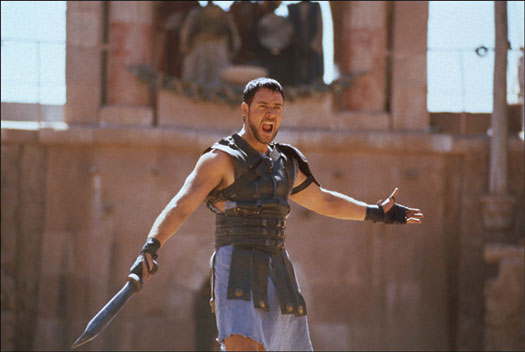History 201

The hit movie Gladiator, starring Russell Crowe, helped fuel misconceptions about ancient Rome. Getty Images.
Gladiators in Rome and the Roman Empire.
In the 2000 film Gladiator, starring Russell Crowe, there’s a fleeting scene during which the Coliseum gate opens, unveiling a gladiator urinating out of fear. “He wouldn’t make it in Rome,” says Marc Kleijwegt, a UW professor of history who should know — after all, he teaches a course about Roman gladiators, the trained combatants who engaged in fighting as a means of public entertainment.
Covering one of the most captivating topics in ancient history, the class draws students pursuing majors across the academic spectrum, including sociology, economics, science, and, naturally, history. The course is also part of the Historian’s Craft, a new requirement for history majors that features unique topics each semester and helps prepare students for a capstone seminar.
Combating misconceptions
Along with improving students’ writing, research, and critical-thinking skills, Kleijwegt is eager to strike down common misconceptions of gladiators. For one, the notion that gladiatorial games involved major bloodshed or slaughter — though intriguing for Hollywood — is simply inaccurate.
“I’m not arguing that it was completely absent from Roman perception of gladiators,” he says, “but it’s quite evident that when gladiators were paired with one another, there was some thinking behind that. They were evenly matched, but differently equipped.”
Several other factors took precedence over fighting to the death: the parity of matchups, the kinship among gladiators, the expense of training them, and their ability to injure rather than kill. Defeated gladiators could even be spared if they showed courage in the face of death.
“[Observers] found it highly interesting and very important that even people who have no value and no status can show courage in the arena,” Kleijwegt says.
Avoiding a modern lens
It’s a natural instinct for people to draw comparisons between historical and current events. However, Kleijwegt cautions, it’s nearly impossible to accomplish with a subject that is more than fifteen hundred years old.
“I think there’s no way in which we can identify with what the Romans felt about gladiators,” he says. “Let’s imagine someone is really enthusiastic about them and wants to see bloodshed — and those people must have been there as well — but we have nothing to compare it to.”
Although American football is a popular comparison, Kleijwegt says it’s valid only up to a limited point. “Do we really want Brett Favre to die on the field?” he asked rhetorically during his first lecture.
Shifting morals
Evidence suggests that Roman society had varying moral opinions of the gladiatorial games. Even the enthusiasts had to deal with cognitive dissonance — being able to cheer gladiators as heroes within the coliseum, while recognizing their role in society as disqualified citizens with a degrading profession.
“I like diversity and complexity, rather than uniform visions, of a particular concept or a particular event in ancient society,” Kleijwegt says.
Highly overrated truth
Academics like to emphasize the importance of why and how things happened, not just what.
That concept becomes a provocative phrase in Kleijwegt’s syllabus and lectures: “The truth in history is highly overrated.” He means that aside from indisputable facts — such as the date of a key battle or assassination — there will always be differing, evolving perspectives and understanding of historical events.
“Students come up to me and say, ‘I’m really interested in history. I want to know what happened,’ ” he says. “Well, what happened is only one [aspect] of history. What happened before that and after that — those are things that are always open to different interpretations.”
Published in the Winter 2013 issue



Comments
No comments posted yet.